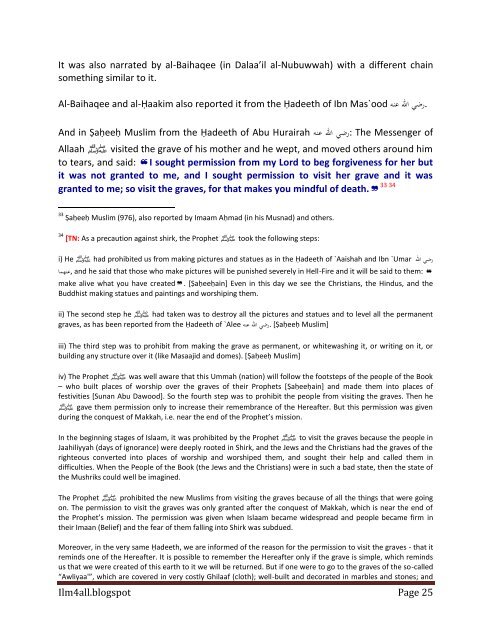You also want an ePaper? Increase the reach of your titles
YUMPU automatically turns print PDFs into web optimized ePapers that Google loves.
It was also narrated by al-Baihaqee (in Dalaa’il al-Nubuwwah) with a different chain<br />
something similar to it.<br />
.رضيُاهللُعنه <strong>Al</strong>-Baihaqee and al-Ḥaakim also reported it from the Ḥadeeth of Ibn Mas`ood<br />
And in Ṣaḥeeḥ Muslim from the Ḥadeeth of Abu Hurairah :رضيُاهللُعنه The Messenger of<br />
<strong>Al</strong>laah ﷺ visited the grave of his mother and he wept, and moved others around him<br />
to tears, and said: ❝I sought permission from my Lord to beg forgiveness for her but<br />
it was not granted to me, and I sought permission to visit her grave and it was<br />
33 34<br />
granted to me; so visit the graves, for that makes you mindful of death.❞<br />
33 Ṣaḥeeḥ Muslim (976), also reported by Imaam Aḥmad (in his Musnad) and others.<br />
34 [TN: As a precaution against shirk, the Prophet ﷺ took the following steps:<br />
رضيُ هللا had prohibited us from making pictures and statues as in the Ḥadeeth of `Aaishah and Ibn `Umar ُ ﷺ i) He<br />
❝ them: and he said that those who make pictures will be punished severely in Hell-Fire and it will be said to ,عنهما<br />
make alive what you have created❞. [Ṣaḥeeḥain] Even in this day we see the Christians, the Hindus, and the<br />
Buddhist making statues and paintings and worshiping them.<br />
ii) The second step he ﷺ had taken was to destroy all the pictures and statues and to level all the permanent<br />
graves, as has been reported from the Ḥadeeth of `<strong>Al</strong>ee ُ هللا ُ . [Ṣaḥeeḥ Muslim]<br />
Ilm4all.blogspot Page 25<br />
عنه رضي<br />
iii) The third step was to prohibit from making the grave as permanent, or whitewashing it, or writing on it, or<br />
building any structure over it (like Masaajid and domes). [Ṣaḥeeḥ Muslim]<br />
iv) The Prophet ﷺ was well aware that this Ummah (nation) will follow the footsteps of the people of the Book<br />
– who built places of worship over the graves of their Prophets [Ṣaḥeeḥain] and made them into places of<br />
festivities [Sunan Abu Dawood]. So the fourth step was to prohibit the people from visiting the graves. Then he<br />
gave them permission only to increase their remembrance of the Hereafter. But this permission was given ﷺ<br />
during the conquest of Makkah, i.e. near the end of the Prophet’s mission.<br />
In the beginning stages of Islaam, it was prohibited by the Prophet ﷺ to visit the graves because the people in<br />
Jaahiliyyah (days of ignorance) were deeply rooted in Shirk, and the Jews and the Christians had the graves of the<br />
righteous converted into places of worship and worshiped them, and sought their help and called them in<br />
difficulties. When the People of the Book (the Jews and the Christians) were in such a bad state, then the state of<br />
the Mushriks could well be imagined.<br />
The Prophet ﷺ prohibited the new Muslims from visiting the graves because of all the things that were going<br />
on. The permission to visit the graves was only granted after the conquest of Makkah, which is near the end of<br />
the Prophet’s mission. The permission was given when Islaam became widespread and people became firm in<br />
their Imaan (Belief) and the fear of them falling into Shirk was subdued.<br />
Moreover, in the very same Ḥadeeth, we are informed of the reason for the permission to visit the graves - that it<br />
reminds one of the Hereafter. It is possible to remember the Hereafter only if the grave is simple, which reminds<br />
us that we were created of this earth to it we will be returned. But if one were to go to the graves of the so-called<br />
“Awliyaa'”, which are covered in very costly Ghilaaf (cloth); well-built and decorated in marbles and stones; and


